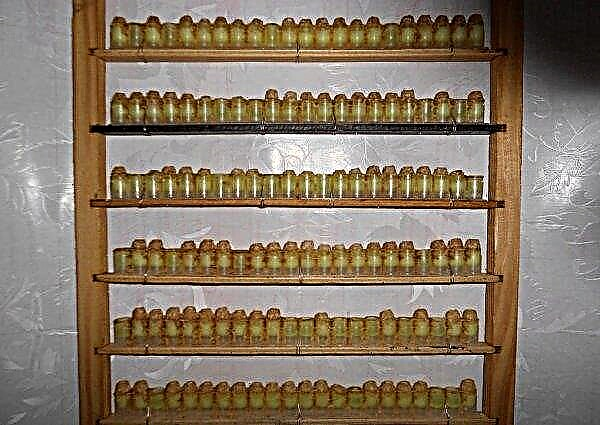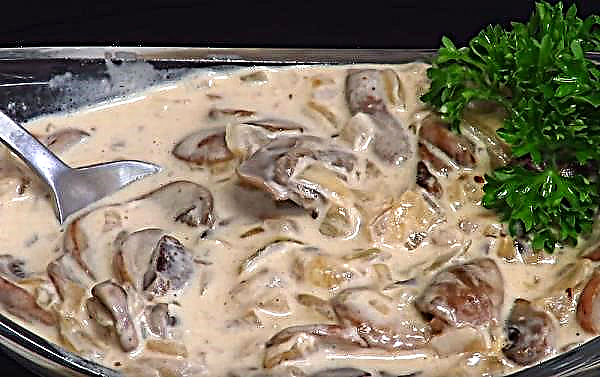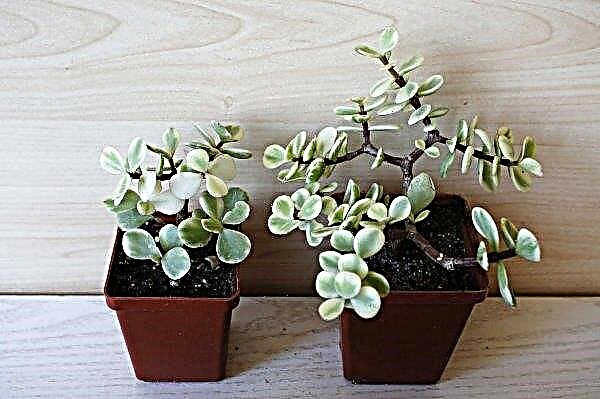Aeschinanthus is a plant that can rarely be found both in florist houses and in specialized stores. Among the many species of this plant, eskhinantus Mona Lisa is considered the most unpretentious and undemanding in care. Read more about this exotic plant in the article below.
Botanical description of the plant
The homeland of the flower is considered to be the southeast of Asia, namely: tropical forests of Vietnam, Indonesia, Malaysia, Thailand. In the natural habitat, he prefers to grow on trees or stones, wrapping around them. The plant is considered an evergreen perennial with an exotic appearance.
Did you know? From Greek eskhinantus is translated as a "distorted flower", and all because the flowers of eskhinantus look as if they were turned upside down.
The flowers are curved tubes of bright red color with peeking white stamens, are located at the ends of the shoots, bloom from May to September. The stems are long, curly, directed upwards, to which the shiny leaves of dark olive color are densely attached.
Growing conditions
Eshinantus among flower growers is considered a fastidious plant, but if you properly care for it, following all the tips, then it will not cause much trouble.
Placement and lighting
Eskhinantus Mona Lisa prefers well-lit places, protected from direct sunlight, with diffused light, since burns can appear on the leaves from the sun. It is best placed on window sills on the west or east side of the house. It is also necessary to provide the plant with a long daylight, if necessary, it should be additionally highlighted.
Temperature mode
Like any other tropical plants, this flower is very thermophilic and does not tolerate sharp temperature drops and drafts. In the warm season, it is advisable to keep it at a temperature of +23 ... + 26 ° С, in winter, the temperature can be slightly reduced to +16 ... + 18 ° С.
Important! To form the buds, the flower must be placed in a cool place, providing him peace.
When the temperature drops below + 15 ° C, the plant may become ill. 
Air humidity
In summer, in hot weather, the eschinanthus Mona Lisa must be constantly sprayed from the spray gun (1-2 times a day) without falling onto the flowers, or a container of water should be placed next to the flowerpot. In winter, there is no need for such moisture, only if the room is very warm. Water for spraying should be at room temperature, settled and soft.
Home Care
In order for the flower to have a beautiful and healthy appearance, he needs to ensure proper care, which consists in regular watering, fertilizing, pruning bushes and timely transplanting.
Did you know? Aeschinanthus is also called a “lipstick flower” because of purple bracts that resemble lipstick.
Watering
Eschinanthus should be watered moderately when the topsoil is dry. Do this 1-2 times a week with room temperature water, which must be left standing for 1-2 days. It is important not to allow the land to be waterlogged and not to forget to drain the remaining water in the pan, avoiding its stagnation.
Fertilizer application
It is recommended to feed eschinanthus during flowering 1-2 times a month, and it is better to apply fertilizers directly to the soil, thereby preventing root burns. It is best to use mineral fertilizers such as Zelenite (100 ml per 10 liters of water) or Rose (2 scoops per 10 liters of water).
Pruning
To make the flower look beautiful and aesthetically pleasing, it must be cut periodically. After the plant fades, long and obsolete shoots are removed, which allows young branches to grow better and form more flowers.
Transfer
It is advisable to transplant a flower every spring in a warm season, it is better to do this after pruning. Eskhinantus Mona Lisa prefers tight containers, so the next pot should be only 2-3 cm wider than the previous one. Soil can be bought at a flower shop, and can also be prepared at home. To do this, mix humus, sand, peat and leafy soil in a ratio of 1: 1: 1: 2. You can also add some charcoal or pine bark for better air permeability. At the bottom of the pot as a drainage you need to put pebbles or expanded clay.
To do this, mix humus, sand, peat and leafy soil in a ratio of 1: 1: 1: 2. You can also add some charcoal or pine bark for better air permeability. At the bottom of the pot as a drainage you need to put pebbles or expanded clay.
Important! It is necessary to transplant the flower by transshipment, thereby preventing damage to the roots.
Propagation at home
Escinanthus Mona Lisa can propagate independently by cuttings or seeds. Experts recommend the first method, since it is much easier to implement.
To do this, you must adhere to the following algorithm of actions:
- Put the cut shoots with 2-3 knots and a length of 5-6 cm into a container with a substrate (a mixture of peat, sand, moss in a ratio of 1: 1: 1), pre-treating cuttings of cuttings with the growth stimulator Kornevin, Epin, etc.
- Cover with plastic wrap or a glass jar.
- Keep at + 26 ° C.
- Watering through a pan.
- Ventilate seedlings periodically.
- To remove a film after emergence of roots on saplings.

The second method is used very rarely and is as follows:
- Sow the seeds in the prepared substrate and cover with a film.
- Keep in a well-lit place at a temperature of +23 ... + 25 ° С.
- Pour into the pan.
- After seed germination, seedlings need to be ventilated periodically.
- After 2-3 weeks, the film should be removed.
- Transplant seedlings into separate pots.
Pest and Disease Control
The main pests and diseases affecting the flower include:
- Spider mite - forms gray-brown spots on the leaves, which are washed off well with warm water.
- Shield - destroyed with a soap solution or Actellik (2 ml per 2 l of water).
- Mealybug - is in the axils of the leaves and prevents them from growing normally. It is eliminated by means of Fitoverm (2 ml per 200 ml of water) or Aktara (1 g per 1.3 l of water).
- Gray rot and powdery mildew - manifested by the appearance of mold on the lower surface of the sheets due to increased humidity. You can fight them with a solution of the drug "Fundazol" (10 g per 10 liters of water).
Eskhinantus Mona Lisa is considered to be a demanding flower care, so it can rarely be found in home collections of indoor plants. However, due to its exotic appearance and luxurious flowering, it is gradually gaining popularity among flower growers and is increasingly appearing in their homes.












